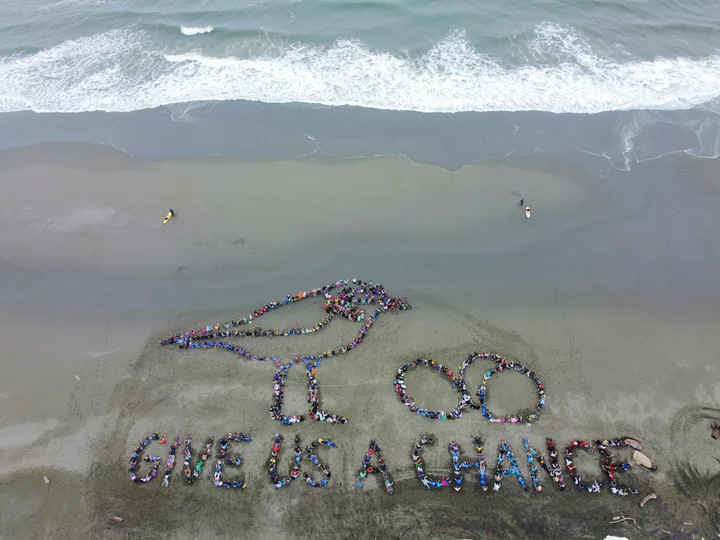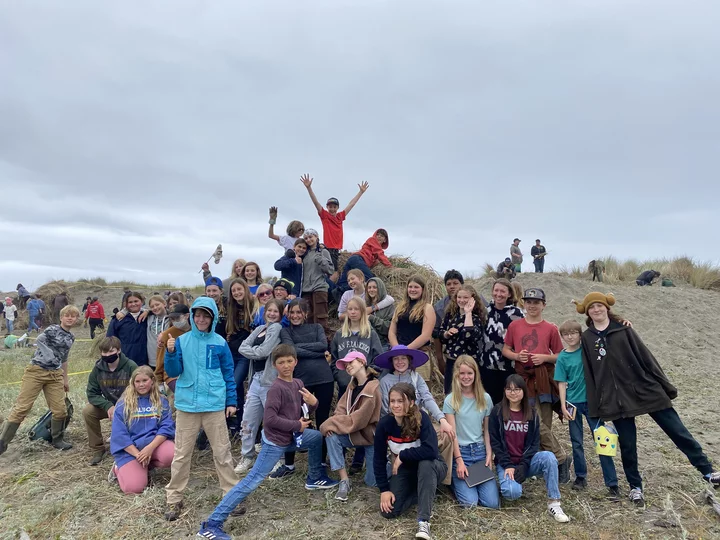Photo: Justin Legge.
Press release from Friends of the Dunes:
On the morning of June 8 (World Ocean Day) about 700 local students spent their school day caring for the coast during the 18th Annual Kids Ocean Day event at the Mike Thompson Wildlife Area, South Spit of the Humboldt Bay. After spending the day restoring dune habitat and picking up trash, students, teachers, and volunteers formed a giant image of a western snowy plover and nest with the message “Give Us A Chance.” The aerial art image was designed by Jess Barger, and captured by drone pilot and photographer Justin Legge.
Friends of the Dunes and the Bureau of Land Management Arcata Field Office organize the Kids Ocean Day event locally with help from Watersheds Stewards Project and California State Parks Lifeguards. Kids Ocean Day is part of a statewide Adopt-a-Beach program funded by the California Coastal Commission. Humboldt County’s event is one in a series of student cleanups and aerial art displays at five locations along the California Coast throughout late May and early June, leading up to World Ocean Day. Prior to these events, students receive classroom presentations highlighting the biodiversity of our coasts and ocean, highlighting the many benefits of healthy coastal ecosystems. Students also learn about human relationships with the natural world around us. As individuals, we can make choices that lessen our environmental impact, such as reducing, reusing, and recycling. As a community, we can have an even larger positive impact. Kids Ocean Day is an annual celebration and a day of action. At the five events along the California coast, over 7,500 students spent the day cleaning up litter and marine debris in an effort to keep our beaches, oceans, and waterways clean and healthy. In Humboldt, students focus on removing non-native, invasive plant species to create space for native biodiversity and cleaning up trash.
“This year Kids Ocean Day lined up with World Ocean Day, so it’s a wonderful opportunity to really highlight how we are all connected to our ocean and coastal habitats,” said Emily Baxter, Friends of the Dunes Education Coordinator. “It’s an extraordinary opportunity to foster a connection between all of these students and our local environments through stewardship. It gives them a chance to help make a difference and to be part of the solution.”
Photo: Daisy Ambriz-Peres.
For this year’s event, we chose the image of a western snowy plover and its nest because this threatened species is an excellent indicator of healthy, thriving coastal environments. The western snowy plover is a small ground-nesting shorebird that breeds on beaches and river bars from Baja to Washington. These birds face many challenges to breeding success, including nest predation by animals such as ravens, crows, and skunks, in addition to the loss of habitat. Snowy plovers have higher breeding success in coastal areas with native vegetation, as opposed to beaches that have been invaded by non-native plant species such as European Beachgrass (Ammophila arenaria). But our message is not just about plovers. The “us” represents all nature, the kids forming the image, and future generations. The unhatched eggs represent hope for the future - a new opportunity to support healthy, thriving coastal environments. Restoration of our coastal dunes supports increased biodiversity of plant and animal life and increased resilience to sea level rise. When given a chance, kids are excited to step up and help care for these coastal environments that they love.
Participating Schools included: Fuente Nueva Charter School, Creekside Arts & Education, Bridgeville Elementary, Pacific Union School, Eureka High, Gnome’s Forest, Jacoby Creek School, Zane Middle School, Trinidad Elementary, Big Lagoon Elementary, Blue Lake Elementary, Scotia Elementary, Orick School, Washington Elementary, Lafayette Elementary, and Sunny Brae Middle School.
Friends of the Dunes is dedicated to conserving the natural diversity of coastal environments through community-supported education and stewardship programs. Projects include the Bay to Dunes school education program, Dune Ecosystem Restoration Team, and the Humboldt Coastal Nature Center. For more information visit friendsofthedunes.org.
The Bureau of Land Management’s Arcata Field Office is responsible for the administration of natural resources, lands, and mineral programs on approximately 200,000 acres of public land in Northwestern California. The Area includes the 60,000-acre King Range National Conservation Area and the 7,472-acre Headwaters Forest Reserve.
This annual event was started by the Malibu Foundation for Environmental Education and the California Coastal Commission in Los Angeles in 1994. With Whale Tail License Plate funding, this program expanded to the North Coast in 2005. The program focuses on reaching children in underserved and inland schools. Our statewide Kids Ocean Day partners include I Love a Clean San Diego, Orange County Coastkeeper, the Malibu Foundation for Environmental Education, the Marine Science Institute, California Coastal Commission, and Spectral Q Aerial Art.
The California Coastal Commission is committed to protecting and enhancing California’s coast and ocean for present and future generations. It does so through careful planning and regulation of environmentally-sustainable development, strong public participation, education, and effective intergovernmental coordination. The Kids’ Ocean Day program is part of the Commission’s effort to raise public awareness of marine and coastal resources and promote coastal stewardship. Funding for this program comes from sales of the WHALE TAIL® License Plate and donations to the Protect Our Coast and Oceans Fund on the California state tax return. For more information about the California Coastal Commission’s programs and how to buy a Whale Tail Plate, call (800) COAST-4U or visit www.coastforyou.org.


CLICK TO MANAGE